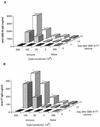Immunologic memory induced by a glycoconjugate vaccine in a murine adoptive lymphocyte transfer model
- PMID: 9573085
- PMCID: PMC108159
- DOI: 10.1128/IAI.66.5.2026-2032.1998
Immunologic memory induced by a glycoconjugate vaccine in a murine adoptive lymphocyte transfer model
Abstract
We have developed an adoptive cell transfer model in mice to study the ability of a glycoprotein conjugate vaccine to induce immunologic memory for the polysaccharide moiety. We used type III capsular polysaccharide from the clinically relevant pathogen group B streptococci conjugated to tetanus toxoid (GBSIII-TT) as our model vaccine. GBS are a major cause of neonatal infections in humans, and type-specific antibodies to the capsular polysaccharide protect against invasive disease. Adoptive transfer of splenocytes from mice immunized with the GBSIII-TT conjugate vaccine conferred anti-polysaccharide immunologic memory to naive recipient mice. The transfer of memory occurred in a dose-dependent manner. The observed anamnestic immune response was characterized by (i) more rapid kinetics, (ii) isotype switching from immunoglobulin M (IgM) to IgG, and (iii) 10-fold-higher levels of type III-specific IgG antibody than for the primary response in animals with cells transferred from placebo-immunized mice. The adoptive cell transfer model described in this paper can be used for at least two purposes: (i) to evaluate conjugate vaccines with different physicochemical properties for their ability to induce immunologic memory and (ii) to study the cellular interactions required for an immune response to these molecules.
Figures




Similar articles
-
Murine immune responses to Neisseria meningitidis group C capsular polysaccharide and a thymus-dependent toxoid conjugate vaccine.Infect Immun. 1998 Nov;66(11):5450-6. doi: 10.1128/IAI.66.11.5450-5456.1998. Infect Immun. 1998. PMID: 9784556 Free PMC article.
-
Immunologic memory response induced by a meningococcal serogroup C conjugate vaccine using the P64k recombinant protein as carrier.FEMS Immunol Med Microbiol. 2006 Mar;46(2):169-79. doi: 10.1111/j.1574-695X.2005.00025.x. FEMS Immunol Med Microbiol. 2006. PMID: 16487298
-
Neonatal mouse protection against infection with multiple group B streptococcal (GBS) serotypes by maternal immunization with a tetravalent GBS polysaccharide-tetanus toxoid conjugate vaccine.Infect Immun. 1994 Aug;62(8):3236-43. doi: 10.1128/iai.62.8.3236-3243.1994. Infect Immun. 1994. PMID: 8039893 Free PMC article.
-
Immune responses of young mice to pneumococcal type 9V polysaccharide-tetanus toxoid conjugate.Infect Immun. 1994 Jul;62(7):2754-60. doi: 10.1128/iai.62.7.2754-2760.1994. Infect Immun. 1994. PMID: 8005665 Free PMC article.
-
Functional activity of antibodies to the group B polysaccharide of group B streptococci elicited by a polysaccharide-protein conjugate vaccine.Infect Immun. 1994 May;62(5):1593-9. doi: 10.1128/iai.62.5.1593-1599.1994. Infect Immun. 1994. PMID: 8168919 Free PMC article.
Cited by
-
A Novel Hexavalent Capsular Polysaccharide Conjugate Vaccine (GBS6) for the Prevention of Neonatal Group B Streptococcal Infections by Maternal Immunization.J Infect Dis. 2019 Jun 5;220(1):105-115. doi: 10.1093/infdis/jiz062. J Infect Dis. 2019. PMID: 30778554 Free PMC article.
-
B cell mediated priming following pneumococcal colonization.Vaccine. 2007 Mar 1;25(11):2036-42. doi: 10.1016/j.vaccine.2006.11.039. Epub 2006 Nov 28. Vaccine. 2007. PMID: 17240006 Free PMC article.
-
A mechanism for glycoconjugate vaccine activation of the adaptive immune system and its implications for vaccine design.Nat Med. 2011 Nov 20;17(12):1602-9. doi: 10.1038/nm.2535. Nat Med. 2011. PMID: 22101769 Free PMC article.
-
Progress toward a group B streptococcal vaccine.Hum Vaccin Immunother. 2018;14(11):2669-2681. doi: 10.1080/21645515.2018.1493326. Epub 2018 Jul 16. Hum Vaccin Immunother. 2018. PMID: 29995578 Free PMC article.
-
Mechanism of Antigen Presentation and Specificity of Antibody Cross-Reactivity Elicited by an Oligosaccharide-Conjugate Cancer Vaccine.J Am Chem Soc. 2023 May 3;145(17):9840-9849. doi: 10.1021/jacs.3c02003. Epub 2023 Apr 23. J Am Chem Soc. 2023. PMID: 37089019 Free PMC article.
References
-
- Anonymous. In vitro assays for mouse lymphocyte function. In: Coligan J E, Kruisbeek A M, Margulies D H, Shevach E M, Strober W, editors. Current protocols in immunology. New York, N.Y: John Wiley & Sons, Inc.; 1994. pp. 3.1.2–3.6.4. - PubMed
-
- Anonymous. Immunofluorescence and cell sorting. In: Coligan J E, Kruisbeek A M, Margulies D H, Shevach E M, Strober W, editors. Current protocols in immunology. New York, N.Y: John Wiley & Sons, Inc.; 1994. pp. 5.3.1–5.4.13.
-
- Baker C J, Edwards M S. Group B streptococcal infections. Perinatal impact and prevention methods. Ann N Y Acad Sci. 1988;549:193–202. - PubMed
-
- Baker C J, Rench M A, Edwards M S, Carpenter R J, Hays B M, Kasper D L. Immunization of pregnant women with a polysaccharide vaccine of group B Streptococcus. N Engl J Med. 1988;319:1180–1220. - PubMed
-
- Baker C J, Rench M A, Kasper D L. Response to type III polysaccharide in women whose infants have had invasive group B streptococcal infection. N Engl J Med. 1990;322:1857–1860. - PubMed
Publication types
MeSH terms
Substances
Grants and funding
LinkOut - more resources
Full Text Sources
Other Literature Sources

